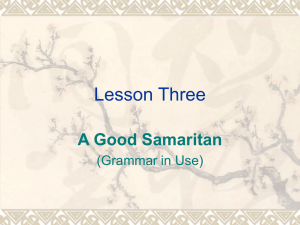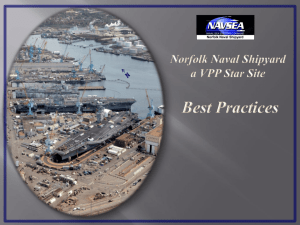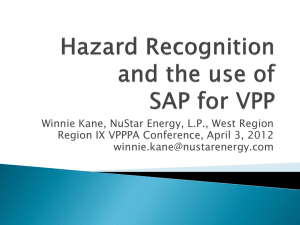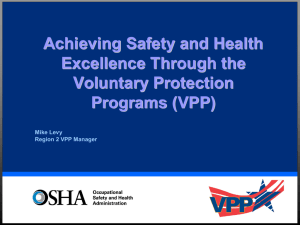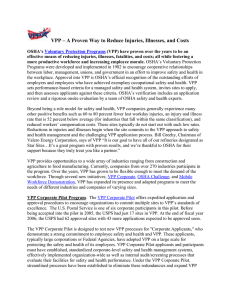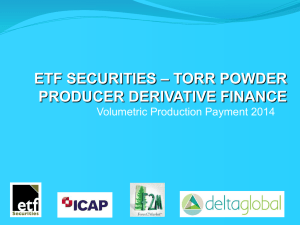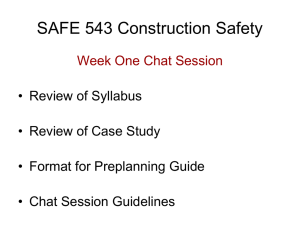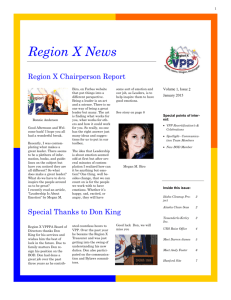Maintaining STAR Quality
advertisement
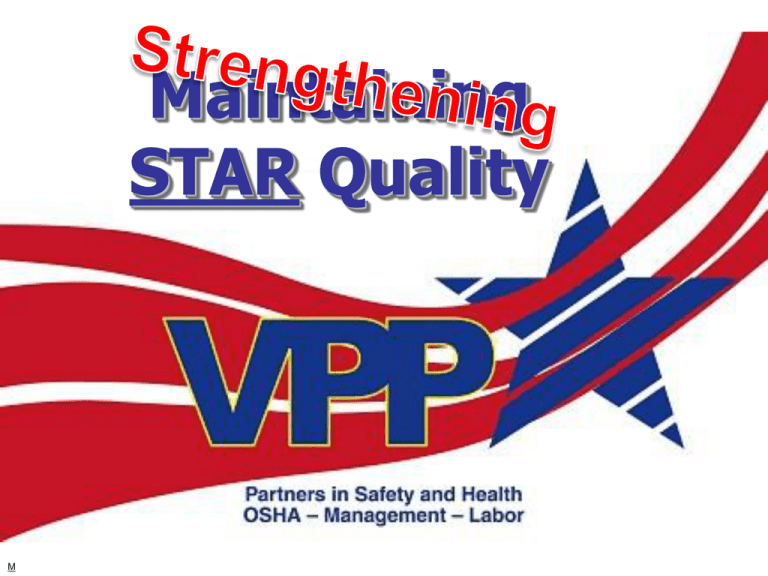
Maintaining STAR Quality M AGENDA M Introductions Recertification Deficiencies Review VPP Benefits & Principles Breakout Sessions Developing a Strategy Introductions Name Company Star Status Union / Non-union Next Certification (months) What is your key take-a-way? Note: This is an interactive session! M What is VPP STAR? A program that recognizes worksites that have achieved & are maintaining excellence in worker safety & health protection through cooperation with & among labor, management, & government D Are we Maintaining? • Since last certification have you seen: – Roller Coaster performance – Change in management – Expansion – Reduction in Force (RIF) – Loss of focus – Economic impact – Lost momentum D What is OSHA seeing! D Management Commitment (Recertification findings) • • • • • Change of management personnel?? Redirection of priorities (production vs. safety) Less time spent on Safety/VPP Less resources for safety ($$) Less management knowledgeable about safety & health/ VPP process • New company owners, do they care? M Employee Involvement (Recertification findings) • Less employees involved in all aspect of VPP evaluation (open to close!) • There must be 3 meaningful ways for employees to participate – If you eliminate one means of participation, you must come up with another • New employees not knowledgeable of VPP or elements • LTA follow-up with employee suggestions or reports of hazards M Worksite Analysis (Recertification findings) • Site no longer performs monthly inspections or ensures a quarterly coverage of entire site. • New equipment, process or chemicals and no new IH sampling • New process no JSA/JHA • New equipment and no specific LOTO procedures • Analyze new equipment for safety prior to purchase (ie- machine guarding) M Hazard Prevention and Control (Recertification findings) • Site not following the hierarchy of controls • Emergency drills not held annually • First Aid/CPR responders must be on all shifts • Inadequate contractor safety program M Safety & Health Training (Recertification findings) • Inadequate training for new hires • Inadequate training for temporary employees • Lack of Knowledge of VPP • Lack of hazard recognition skills as evidenced by numerous hazards noted on walkthroughs M Again, Are we Maintaining? • Since last certification have you seen: – Roller Coaster performance – Change in management – Expansion – Reduction in Force (RIF) – Loss of focus – Economic impact – Lost momentum M What are we going to do? Get Back to Basics! You did it before! Courage & Conviction Motivate, Inspire, Believe Integrity, Honesty Accountability D Why VPP? • Creates Effective Management Tools – process to incorporate safety at facilities • Strengthens Cooperative Relationships – networking between facilities and OSHA • Increases Networking Resources • Works Toward Enhancing Labor & Management Relations – improves dialogue M Who Benefits? • Workers – fewer injuries/illnesses/lost restricted cases, safer work environment • Unions – labor management cooperation sets tone for improved cooperation in other areas • Employers – lower work related cost, increased moral and productivity • Industry – partnership with employees & OSHA • OSHA – establish cooperative relationships, M VPP Principles • Voluntarism • Cooperation • A Management System Approach • Model Worksites for Safety & Health • Continuous Improvement • Employee and Employer Rights M Categories of Participation • Star Programs – are self-sufficient in identifying & controlling workplace hazards • Merit Programs – show willingness, commitment & ability to achieve site-specific goals • Star Demonstration Programs – show star quality safety & health management systems that differs from the VPP module M Why a strong Safety Culture? It has been observed at the OSHA VPP sites that developing strong safety cultures have the single greatest impact on Accident Reduction It is for this single reason that developing these cultures should be top priority for all Managers and Supervisors M Why a strong Safety Culture? Have you conducted any Culture scans? This will tell you what you already know.. And what you may not know… M M Breakout Sessions Four Elements of VPP • Management Leadership & Employee Involvement • Worksite Analysis • Hazard Prevention & Control • Safety & Health training D Management Leadership Name some items you can use as a measurement tool to determine how you are doing on management leadership M Employee Involvement How many ways can you get your employees involved in VPP? How do you measure your level of employee involvement? Employee Involvement How many ways can you get your employees involved in VPP? How do you measure your level of employee involvement? Worksite Analysis How many different ways can you conduct worksite analysis? What tools do you have to measure the effectiveness of your worksite systems & activities? M Hazard Prevention and Control Name some items you can use as a measurement tool to determine how well you are preventing, eliminating, controlling hazards at your facility M Safety & Health Training What training techniques are you using and are they working? What can you do better in the overall training process? How can you measure your training success? M Breakout Sessions Reports Management Leadership Name some items you can use as a measurement tool to determine how you are doing on management leadership M Management Leadership • Establish communication • Maintaining a written system • Identifying roles responsibilities • Accountability • Providing Resources • Setting an Example • Provide safety & health protection • Conducting system evaluations • Training M Good Management Leadership HAS: • • • • • • M Commitment at all levels Leading by example Clear goals and objectives Hold reports accountable Provide adequate resources Reality of work activities Employee Involvement How many ways can you get your employees involved in VPP? How do you measure your level of employee involvement? Employee Involvement • Right to notify & being involved in the solution • • • • • • • M Safety & Health training of other employees Analysis of job/process hazards Participating in audits Ad hoc S&H problem-solving groups. Employee improvement suggestion programs Safety observers Attending OSHA conferences Worksite Analysis How many different ways can you conduct worksite analysis? What tools do you have to measure the effectiveness of your worksite systems & activities? M Worksite Analysis • • • • • • • • • M Results of site inspections Number & type of employees Suggestions and complaints Industrial hygiene monitoring Medical surveillance results Minutes of Safety and Health meetings Accident & near-miss reporting& Incident investigations Written Safety practices Hazard Prevention and Control Name some items you can use as a measurement tool to determine how well you are preventing, eliminating, controlling hazards at your facility Hazard Prevention and Control • • • • • • • • • M Follow-up data on site inspections Tracking safety Employee suggestions, complaints, etc Results from IH monitoring & medical Results in incident investigations Near miss / injury reporting follow-up Review of job hazard analyses Review of written safety / policy procedures Hazard Assessments Safety & Health Training What training techniques are you using and are they working? What can you do better in the overall training process? How can you measure your training success? M Safety & Health Training • • • • • • • M New employee training documentation Knowledge verification process Group or shift safety meeting minutes Accurate employee training records Effective Safety & Health procedures training Personal Protective Equipment training Qualified train the trainers Developing your Strategy Developing Your Strategy Do your own audit •Build a reporting tracking system – Access or sequel database – include all safety & health information • Capture everything – site inspections, incidents, audits, etc.. – employee recommendations M Developing Your Strategy • Mentoring (What is it, who do I call?) • When do you call OSHA for a recertification date • Can I ask who is coming? • I heard there were changes to the audit? Back to Basics! M Developing Your Strategy • Take a day to analyze • Create reports to include – Communicate your findings.. – Teach others – Create action plans from the data – Trending data by department, type etc.. Here is my example.. M Conditions at time of Injury 16 16 14 12 # of Injuries 10 16 16 16 15 13 11 11 11 9 N o P r o c 11 8 6 4 7 L T A 2 0 Note: Data taken from injury reports & interviews M Experience Accident Rate Stage 1 Stage 2 Stage 3 Anxiety Maximum Hazard Recognition and Response Habituation Concern Knowledge and skills Hazard Recognition and Response Rookie Veteran TASK FAMILIARIZATION M Developing Your Strategy • Capture significant changes • Train a core group of VPP “experts” • Conduct annual self evaluation • Use OSHA on site review process • Evaluations performance based • Be visible & accessible to employees • Attend OSHA Conferences & share • Educate your employees on VPP • Create a timeline M Onsite Review • Interviews • Site walk down • Documentation review • Lunch Time • 90 Day items • Daily open and close M Summary of Strategy • Maintain documentation • Build a tracking system • Establish systems for data collection • Train a team on VPP “experts” • Use your onsite annual evaluation • Educate your employees • Don’t forget the transfers M "There can be no work more rewarding and no job more fulfilling than helping to protect the lives and well-being of the working men and women who keep our nation strong. We can make a difference and we will." John L. Henshaw, Assistant Secretary of Labor for Occupational Safety and Health M The key to your success is • Networking • Using Best Practices • Courage to try new things • Truly believing • Relentless attitude • OSHA & VPPPA & Partnerships M Maintaining STAR Quality M
